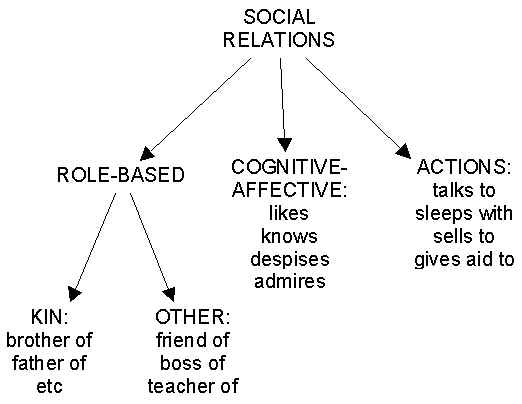
Ego networks consist of a focal node ("ego") and the nodes to whom ego is directly connected to (these are called "alters") plus the ties, if any, among the alters.

Of course, each alter in an ego network has his/her own ego network, and all ego networks interlock to form The human social network.
Egos and alters are tied to each other by social relations. There are various kinds of social relations, including:

Two basic strategies: person-based and relation-based. The person-based strategy uses a set of open-ended questionnaire items known as a name generator. Typically, it is unlimited in scope: the respondent may name anyone from any sphere of life: neighbors, kin, friends, coworkers, etc. After obtaining a large list of names, the interviewer typically goes over each name, asking the respondent about the nature of their relationship with that person (what social relation) and asking about attributes of that person (sex, race, income, etc.). When possible, this is then followed by asking the respondent to indicate relationships among the alters.
The relation-based strategy starts with a relation of interest, such as emotional support, and then asks all the people that the respondent has this particular relationship with. Sometimes this is within the context of a circumscribed group, such as "which of your fellow employees to obtain emotion support from?". If appropriate this is then followed by attributes of the tie, such as duration, intensity, frequency, strength, and so on. If the relation is friendship, might ask strength and duration, but not frequency. If the relation is interacts with, might ask frequency and tenure of the relationship. Attributes of the alters can also be asked.
It should be obvious that random sampling of egos from a large pop will not form a network: it is likely that no ego mentions an alter that is another ego or is an alter of another ego. Hence, certain network measures cannot be obtained from ego network data, such as the number of links that separate people.
Social support. Emotional and material aid. Companionship. Information.
Sense-making. How to interpret the world.
Social control. Ensuring that egos behave according to norms.
Access to resources. Entrepreneurs draw on their contacts to get the clients and employees and consultants they need.
Behavioral models. You tend to talk like the people you talk to. You become aware of choices -- from clothing options to brands of cars to ways of talking and behaving -- from the people in your ego network.
A standing hypothesis about ego networks is that strong ties are homophilous. That is, people have the strongest ties with people who similar to themselves on key attributes, such as social class, age, sex, race, political views, etc.
Another standing hypothesis or guiding principle is that people with heterogeneous networks are "better off". The greater the diversity of their network, the more chance that someone in the network has something ego needs. This is particularly relevant for entrepreneurs.
According to Granovetter, the stronger the tie between EGO and two of her alters, the greater the likelihood that the alters enjoy at least a weak tie. Granovetter also believes that weak ties provide people with access to novel information, whereas your strong ties tend to know the same things you do. Hence, the denser the ties in an ego network, the stronger the ties, and the more insular the ego network and also the more homogeneous.
Typical measures:
| Home | Borgatti | Analytic Technologies | INSNA | Connections |